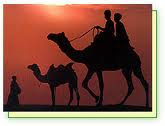That rugged jeep had seen enough of your garage, take it out and hit the roads. Bikers roar your cruiser-buddy. Indian streets are winding, wooded, dirty, yet promise undulating gamble for the ‘roadies’. The romance between the man and the machine apart, Indian safari adventures mean animals as well, and a lot of them. Camels, horses, elephants -- which one are you planning to ride? India sightseeing is best done on animal back. Come to this mystic land, explore the unexplored, and leave rejuvinated! Team it up with extensive photography spree and you can host an exhibition, write for travel blogs (write us a travelogue), and what not!
Some of the best Indian safaris
Jeep Safari:Imagine driving in a jungle, and some predator gives you a chase for your life! Reminds you of the dinosaurs chase scene in The Lost World? Drive your blues away in the craggy hills and muddy roads, wildlife parks and beaches of this incredible land,
 India. In the trans Himalayan region, Leh-Ladakh and Kinnaur-Spiti promise those winding roads, high altitudes, deep gorges and everything that takes to get your heart throbbing and body sweating. The ‘Raid-de-Himalayas’, an annual car-rally, is something you must opt for if you land up just during the program. Rajasthan’s forested valleys and arid hills also give you a different kind of safari flavor. The Shekhawati and Mewar region, Udaipur and Jaisalmer are options you should give a check.
India. In the trans Himalayan region, Leh-Ladakh and Kinnaur-Spiti promise those winding roads, high altitudes, deep gorges and everything that takes to get your heart throbbing and body sweating. The ‘Raid-de-Himalayas’, an annual car-rally, is something you must opt for if you land up just during the program. Rajasthan’s forested valleys and arid hills also give you a different kind of safari flavor. The Shekhawati and Mewar region, Udaipur and Jaisalmer are options you should give a check.Biking Safari:
 Those who have straightaway jumped to this paragraph sure must have read Che Guevara’s Motocycle Diaries or at least seen the movie. And those who have not, and still is a biking-maniac, should check it out, for it inspires endlessly to embark on a biking safari. And if you have made your mind, here is India for you. The Himalayas again are the most enticing with winding and difficult routes, just perfect for the bikers. Ladakh, Himachal Pradesh regions like Kinnaur, Lahaul Spiti, Manali are the zones of interest. While, for rugged countryside biking, try Rajasthan.
Those who have straightaway jumped to this paragraph sure must have read Che Guevara’s Motocycle Diaries or at least seen the movie. And those who have not, and still is a biking-maniac, should check it out, for it inspires endlessly to embark on a biking safari. And if you have made your mind, here is India for you. The Himalayas again are the most enticing with winding and difficult routes, just perfect for the bikers. Ladakh, Himachal Pradesh regions like Kinnaur, Lahaul Spiti, Manali are the zones of interest. While, for rugged countryside biking, try Rajasthan.Elephant Safari:
 Best for exploring the jungles and having the closest and the best possible wildlife encounters, elephant safari is the most common safari option. The national parks and sanctuaries, have safari tours with trained mahouts (guides). Corbett National Park, Periyar Widlife Sanctuary, Kaziranga National Park are famed for their elephant safaris. The sightseeing safaris are best conducted by Rajasthan Tourism to reach their hill-top Forts and of course to tour tourists around the city, alongside their camels.
Best for exploring the jungles and having the closest and the best possible wildlife encounters, elephant safari is the most common safari option. The national parks and sanctuaries, have safari tours with trained mahouts (guides). Corbett National Park, Periyar Widlife Sanctuary, Kaziranga National Park are famed for their elephant safaris. The sightseeing safaris are best conducted by Rajasthan Tourism to reach their hill-top Forts and of course to tour tourists around the city, alongside their camels.Camel Safari:

Wobbling on the camel back is fun, but minus the back-aches. But roosted on its hunch-back as you tour the varied attractions or scale the deserts, anything and everything feels worth the experience. In the Thar Desert of Rajasthan, around Jodhpur, Jaisalmer (Sam sand dunes), and Bikaner, toddling though palaces, old havelis (mansions), oasis --- is rated the best of camel-safari escapades. Jaisalmer to the Rann of Kutch in Gujarat is another exciting route. Special camel safaris are also organized round Pushkar and Nagaur in the winter season of October to March, when these two cities have their popular cattle fairs. Chambal camel safari a must for Agra visitors, that begins with a river cruise conducted by the Pathanias (attraction: close encounters with Ghariyals and Crocodiles) and the camel safari, which takes you to the picturesque Atar Fort.
Vacation Rentals

